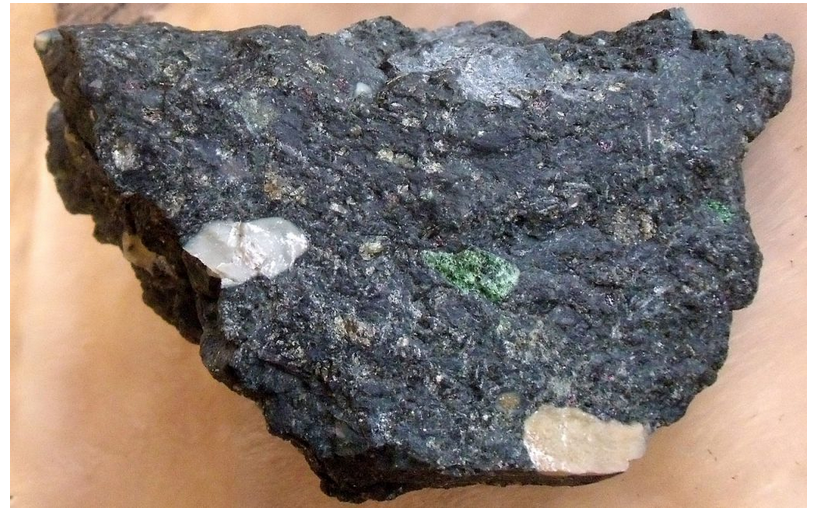9.3.1: Magmatic Ore Deposits
- Page ID
- 18583
\( \newcommand{\vecs}[1]{\overset { \scriptstyle \rightharpoonup} {\mathbf{#1}} } \)
\( \newcommand{\vecd}[1]{\overset{-\!-\!\rightharpoonup}{\vphantom{a}\smash {#1}}} \)
\( \newcommand{\id}{\mathrm{id}}\) \( \newcommand{\Span}{\mathrm{span}}\)
( \newcommand{\kernel}{\mathrm{null}\,}\) \( \newcommand{\range}{\mathrm{range}\,}\)
\( \newcommand{\RealPart}{\mathrm{Re}}\) \( \newcommand{\ImaginaryPart}{\mathrm{Im}}\)
\( \newcommand{\Argument}{\mathrm{Arg}}\) \( \newcommand{\norm}[1]{\| #1 \|}\)
\( \newcommand{\inner}[2]{\langle #1, #2 \rangle}\)
\( \newcommand{\Span}{\mathrm{span}}\)
\( \newcommand{\id}{\mathrm{id}}\)
\( \newcommand{\Span}{\mathrm{span}}\)
\( \newcommand{\kernel}{\mathrm{null}\,}\)
\( \newcommand{\range}{\mathrm{range}\,}\)
\( \newcommand{\RealPart}{\mathrm{Re}}\)
\( \newcommand{\ImaginaryPart}{\mathrm{Im}}\)
\( \newcommand{\Argument}{\mathrm{Arg}}\)
\( \newcommand{\norm}[1]{\| #1 \|}\)
\( \newcommand{\inner}[2]{\langle #1, #2 \rangle}\)
\( \newcommand{\Span}{\mathrm{span}}\) \( \newcommand{\AA}{\unicode[.8,0]{x212B}}\)
\( \newcommand{\vectorA}[1]{\vec{#1}} % arrow\)
\( \newcommand{\vectorAt}[1]{\vec{\text{#1}}} % arrow\)
\( \newcommand{\vectorB}[1]{\overset { \scriptstyle \rightharpoonup} {\mathbf{#1}} } \)
\( \newcommand{\vectorC}[1]{\textbf{#1}} \)
\( \newcommand{\vectorD}[1]{\overrightarrow{#1}} \)
\( \newcommand{\vectorDt}[1]{\overrightarrow{\text{#1}}} \)
\( \newcommand{\vectE}[1]{\overset{-\!-\!\rightharpoonup}{\vphantom{a}\smash{\mathbf {#1}}}} \)
\( \newcommand{\vecs}[1]{\overset { \scriptstyle \rightharpoonup} {\mathbf{#1}} } \)
\( \newcommand{\vecd}[1]{\overset{-\!-\!\rightharpoonup}{\vphantom{a}\smash {#1}}} \)
\(\newcommand{\avec}{\mathbf a}\) \(\newcommand{\bvec}{\mathbf b}\) \(\newcommand{\cvec}{\mathbf c}\) \(\newcommand{\dvec}{\mathbf d}\) \(\newcommand{\dtil}{\widetilde{\mathbf d}}\) \(\newcommand{\evec}{\mathbf e}\) \(\newcommand{\fvec}{\mathbf f}\) \(\newcommand{\nvec}{\mathbf n}\) \(\newcommand{\pvec}{\mathbf p}\) \(\newcommand{\qvec}{\mathbf q}\) \(\newcommand{\svec}{\mathbf s}\) \(\newcommand{\tvec}{\mathbf t}\) \(\newcommand{\uvec}{\mathbf u}\) \(\newcommand{\vvec}{\mathbf v}\) \(\newcommand{\wvec}{\mathbf w}\) \(\newcommand{\xvec}{\mathbf x}\) \(\newcommand{\yvec}{\mathbf y}\) \(\newcommand{\zvec}{\mathbf z}\) \(\newcommand{\rvec}{\mathbf r}\) \(\newcommand{\mvec}{\mathbf m}\) \(\newcommand{\zerovec}{\mathbf 0}\) \(\newcommand{\onevec}{\mathbf 1}\) \(\newcommand{\real}{\mathbb R}\) \(\newcommand{\twovec}[2]{\left[\begin{array}{r}#1 \\ #2 \end{array}\right]}\) \(\newcommand{\ctwovec}[2]{\left[\begin{array}{c}#1 \\ #2 \end{array}\right]}\) \(\newcommand{\threevec}[3]{\left[\begin{array}{r}#1 \\ #2 \\ #3 \end{array}\right]}\) \(\newcommand{\cthreevec}[3]{\left[\begin{array}{c}#1 \\ #2 \\ #3 \end{array}\right]}\) \(\newcommand{\fourvec}[4]{\left[\begin{array}{r}#1 \\ #2 \\ #3 \\ #4 \end{array}\right]}\) \(\newcommand{\cfourvec}[4]{\left[\begin{array}{c}#1 \\ #2 \\ #3 \\ #4 \end{array}\right]}\) \(\newcommand{\fivevec}[5]{\left[\begin{array}{r}#1 \\ #2 \\ #3 \\ #4 \\ #5 \\ \end{array}\right]}\) \(\newcommand{\cfivevec}[5]{\left[\begin{array}{c}#1 \\ #2 \\ #3 \\ #4 \\ #5 \\ \end{array}\right]}\) \(\newcommand{\mattwo}[4]{\left[\begin{array}{rr}#1 \amp #2 \\ #3 \amp #4 \\ \end{array}\right]}\) \(\newcommand{\laspan}[1]{\text{Span}\{#1\}}\) \(\newcommand{\bcal}{\cal B}\) \(\newcommand{\ccal}{\cal C}\) \(\newcommand{\scal}{\cal S}\) \(\newcommand{\wcal}{\cal W}\) \(\newcommand{\ecal}{\cal E}\) \(\newcommand{\coords}[2]{\left\{#1\right\}_{#2}}\) \(\newcommand{\gray}[1]{\color{gray}{#1}}\) \(\newcommand{\lgray}[1]{\color{lightgray}{#1}}\) \(\newcommand{\rank}{\operatorname{rank}}\) \(\newcommand{\row}{\text{Row}}\) \(\newcommand{\col}{\text{Col}}\) \(\renewcommand{\row}{\text{Row}}\) \(\newcommand{\nul}{\text{Nul}}\) \(\newcommand{\var}{\text{Var}}\) \(\newcommand{\corr}{\text{corr}}\) \(\newcommand{\len}[1]{\left|#1\right|}\) \(\newcommand{\bbar}{\overline{\bvec}}\) \(\newcommand{\bhat}{\widehat{\bvec}}\) \(\newcommand{\bperp}{\bvec^\perp}\) \(\newcommand{\xhat}{\widehat{\xvec}}\) \(\newcommand{\vhat}{\widehat{\vvec}}\) \(\newcommand{\uhat}{\widehat{\uvec}}\) \(\newcommand{\what}{\widehat{\wvec}}\) \(\newcommand{\Sighat}{\widehat{\Sigma}}\) \(\newcommand{\lt}{<}\) \(\newcommand{\gt}{>}\) \(\newcommand{\amp}{&}\) \(\definecolor{fillinmathshade}{gray}{0.9}\)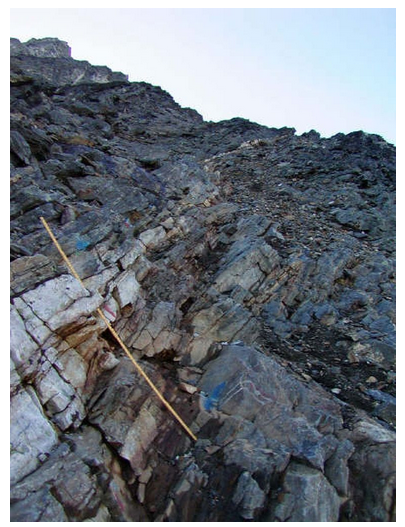
Minerals containing elements of economic value are generally present in all igneous rocks, but the elements may not be concentrated enough to make mining economical. Only in relatively rare circumstances are they in sufficient abundance so that mining is profitable. If the minerals are scattered throughout a host rock, but in sufficient amounts to mine profitably, we call the deposit a disseminated deposit. Disseminated deposits produce most of the world’s diamonds, copper, and molybdenum and also large percentages of the available tin, silver, and mercury. Often, disseminated ores consist of minerals scattered randomly in a host rock.
Sometimes geological processes concentrate ore minerals in vein deposits consisting of veins that are centimeters to meters thick. If ore is distributed in many small veins, geologists call the deposit a lode deposit. Vein deposits account for most of the world’s gold and silver mines, and also some copper and lead-zinc mines. Figure 9.75 shows a meter wide quartz vein that is the source of gold at Nalunaq Gold Mine in southern Greenland. In still other kinds of igneous deposits, ore minerals become concentrated in layers. Below, we look at some of the most important kinds of igneous deposits.
9.3.1.1 Magmatic Sulfides and Cumulates
Mafic and ultramafic magmas, like all common magmas, contain the major elements oxygen, silicon, aluminum, iron, calcium, sodium, potassium, and magnesium. But they typically also contain other elements including sulfur, nickel, and less common metals such as platinum, palladium, and chromium. As these magmas cool and crystallize, the first minerals to form are plagioclase, pyroxene, and olivine – all made of major elements. Consequently, the concentrations of sulfur and other minor elements increase in remaining melt. Eventually, sulfur concentration becomes great enough so that sulfide minerals begin to crystallize. The sulfide minerals, typically containing iron and nickel, may also contain relatively high concentrations of platinum, palladium, and other minor metals.
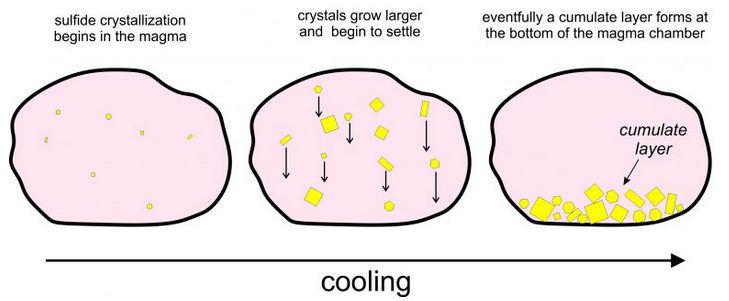
Sulfides have greater densities than silicate minerals and the mafic or ultramafic melts. So, the denser sulfide minerals will, over time, begin to sink, as shown in Figure 9.76 above. Eventually, after more cooling and crystallization, significant deposits of sulfide minerals may accumulate on the bottom of a magma chamber. The deposits, which may form centimeters-, or meters-thick layer called a cumulate, are often entirely, or nearly entirely, composed of sulfide minerals. This process produces magmatic sulfide deposits, which are the most important sources of platinum, palladium, chromium, and several other metals. Cumulate sulfide minerals include pentlandite (Fe,Ni)9S8, chalcopyrite (CuFeS2), pyrrhotite (Fe1-xS), and pyrite (FeS2).
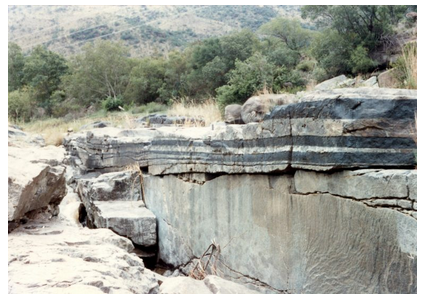
Cumulate sulfide deposits account for almost 60% of the world’s nickel production and more than 95% of platinum and palladium production. These deposits are associated with mafic and ultramafic magmas but not, generally, with felsic magmas, because felsic magmas are so viscous that they cool and crystallize before dense minerals can settle.
Sulfides are not the only kind of mineral that can become concentrated in a cumulate deposit. Oxides – including magnetite (Fe3O4), ilmenite (FeTiO3), and chromite (FeCr2O4) – may settle and collect at the bottom of a magma chamber, too. South Africa’s Bushveld Complex is the most significant and important example of oxide mineral cumulates. Figure 9.77 shows Bushveld chromite layers surrounded by a feldspar-rich rock. These chromite cumulates produce not only significant amounts of chrome, but also very large amounts of platinum, palladium, and related elements.
9.3.1.2 Pegmatites
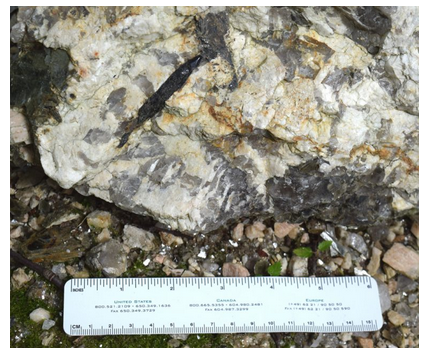
During crystallization, some minerals crystallize before others. Consequently, a late-stage magma will not be the same composition as an original magma. Pegmatite is the name given to coarse-grained igneous rocks that form during the final stage of magma crystallization. Common pegmatites have an overall granitic composition and comprise mostly quartz, feldspar, and mica. But pegmatites share another important characteristic. They also commonly contain minerals made of relatively rare elements that did not go into the early formed minerals. Figure 9.78, for example, contains the common minerals K-feldspar (white) and quartz (gray), but also contains tourmaline (black), a boron mineral. (Biotite is also present but is hard to see in the photo.) So, pegmatites are often mined for minerals rich in boron, cesium, lithium, molybdenum, niobium, tantalum, tin, tungsten, or other elements. For example, pegmatites are sometimes sources of spodumene (an important lithium mineral) and beryl (an important beryllium ore mineral).
Additionally, pegmatites may be a source of gem minerals. Gems from pegmatites include emerald and aquamarine (varieties of the mineral beryl), amazonite (variety of feldspar), apatite, chrysoberyl, garnet, spodumene, lepidolite, topaz, tourmaline, zircon, and others. Most pegmatite mines make their money from mineral specimens and gems rather than from the ore minerals they contain. The minerals in Figures 9.59 – 9.62, earlier in this chapter came from pegmatites, and we saw other examples of pegmatite minerals in Chapter 4 and Chapter 6:
• Figure 4.1 – Aquamarine and tourmaline
• Figure 4.12 – Riebeckite (an amphibole) with K-feldspar and quartz
• Figure 4.13 – Tourmaline
• Figure 4.30 – Emerald (beryl) on quartz
• Figure 6.108 – Tourmaline from a pegmatite
9.3.1.3 Kimberlites
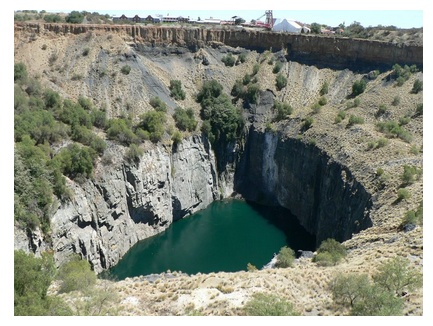
Kimberlites, named after the town of Kimberly, South Africa, where they were first described, are volcanic rocks that originate in Earth’s mantle. They are mined exclusively for diamonds. The photo in Figure 9.79 shows the “Big Hole” at Kimberly. The Hole was mined from 1871 to 1914 and reached a depth of 240 m below the surface. Subsequently it filled with water.
Kimberlite eruptions are gas-powered explosive events. The magmas originate at depths of 150 to 450 km, deeper than other igneous rocks. Most kimberlites are in small vertical columns called kimberlite pipes although some rare sills are known. These pipes are the most important source of diamonds today. If kimberlite weathers and erodes, the diamonds may become concentrated in sedimentary deposits. Some kimberlites bring mantle xenoliths (pieces of mantle rock) to the surface; petrologists use these samples to study mantle chemistry and mineralogy.
Kimberlites are ultramafic rocks, having high magnesium and low silicon contents, and are rich in potassium. Mg-rich olivine and carbonate minerals generally dominate, but some kimberlites contain significant amounts of phlogopite (Mg-rich biotite). Lesser amounts of serpentine, ilmenite, garnet, clinopyroxene, enstatite and chromite may be present. Most kimberlites are very old, having erupted between about 80 million and 2.5 billion years ago. A few younger ones, 10-20,000 years old, are in Tanzania and Democratic Republic of the Congo.
Figure 8.11 (Chapter 8) showed a kimberlite that contains diamonds. Not all kimberlites do. The photo below in Figure 9.80 shows a sample of kimberlite from Baffin Island, Canada. The dark material consists of pyroxene and olivine. The obvious bright green minerals are chrome diopside. Harder-to-see smaller wine-red minerals are Mg-rich garnet. The large light-colored fragments are limestone that got caught up in the kimberlite magma during eruption.
